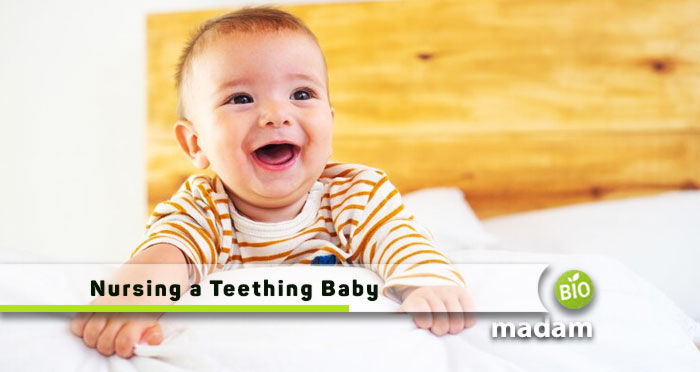As a new parent, you’re no stranger to the multitude of changes your baby undergoes during their early years. One milestone that often raises questions is teething – the process of baby teeth emerging from the gums. Teething can be accompanied by discomfort and challenges, leaving you wondering how to adapt your breastfeeding routine.
However, it’s entirely possible to continue breastfeeding even when your baby has teeth. In this article, we’ll explore breastfeeding during teething, providing insights and tips to make this journey smoother for both you and your little one. We’ll discuss common challenges such as nipple sensitivity and potential biting, and offer practical strategies like ensuring a proper latch and using teething toys for relief. By understanding the nuances of breastfeeding during teething, you can navigate this phase while nurturing your special bond with your baby.
Understanding Teething and Its Phases
Teething marks a significant stage in your baby’s development, typically starting around six months of age. This natural process involves the emergence of baby teeth, also known as deciduous teeth, which play a vital role in aiding your baby’s chewing and speech development. Teething occurs in phases, with each phase marked by the eruption of specific teeth. While this process is a positive sign of your baby’s growth, it can also bring about discomfort due to sore gums and other related symptoms such as drooling, fussiness, and disrupted sleep patterns.
Breastfeeding and Tooth Development
As your baby’s teeth gradually make their appearance, you might wonder how breastfeeding fits into the equation. It’s important to note that the presence of teeth doesn’t necessarily mean the end of breastfeeding. In fact, continuing to breastfeed can offer numerous benefits, including maintaining the intimate bond between you and your baby, providing essential nutrients, and boosting the immune system. Baby teeth serve as an integral part of the breastfeeding process, helping your little one latch and nurse effectively.
Navigating Challenges and Embracing Solutions
- Common Challenges during Teething: Teething can bring about challenges like nipple sensitivity, mild discomfort, and the possibility of biting during breastfeeding.
- Alleviating Nipple Sensitivity: Nipple sensitivity often arises as your baby’s feeding behavior changes during teething. To minimize discomfort, focus on achieving a proper latch. Experiment with different feeding positions to find the one that offers the most relief.
- Soothing Teething Discomfort: Ease your baby’s teething discomfort before breastfeeding sessions. Safe teething toys, cold compresses, and teething gels can help soothe sore gums and create a more comfortable feeding experience.
- Managing Biting Incidents: Biting can be a natural phase during teething, but it’s essential to address it. If your baby bites during breastfeeding, calmly detach them from the breast, explain that biting hurts, and allow them to understand the consequences before resuming feeding.
- Patience and Adaptation: Breastfeeding a teething baby requires patience and adaptation. Every baby is unique, so finding what works best for both of you might take some trial and error. Don’t hesitate to seek guidance from professionals or other mothers who have navigated similar challenges.
Protecting Your Nipples and Promoting Comfort
To safeguard your nipples from the emergence of tiny teeth, consider these techniques:

- Focus on proper latch and positioning to minimize discomfort.
- Experiment with nipple shields or protective barriers to reduce direct contact.
- Maintain excellent nipple hygiene to prevent irritation.
Maintaining Oral Hygiene
Introducing dental care for your baby early on is essential for their oral health. As teeth emerge, start cleaning them gently with a soft, damp cloth. As more teeth appear, transition to a soft baby toothbrush and water. Balancing breastfeeding with dental hygiene ensures your baby’s dental health remains a priority.
Knowing When to Seek Professional Guidance
If you encounter challenges that go beyond the norm, such as severe pain during breastfeeding or concerns about your baby’s oral development, don’t hesitate to seek help from lactation consultants or pediatric dentists. These professionals can offer personalized guidance and support to ensure both you and your baby have a positive breastfeeding experience.
Conclusion – The Journey
Breastfeeding with a teething baby is not only possible but also beneficial for your baby’s overall well-being. Teething is a transient phase that, with a little preparation and understanding, can be navigated successfully. By maintaining a proper latch, employing strategies to address discomfort and potential biting, and prioritizing your baby’s oral hygiene, you can continue to enjoy the cherished moments of breastfeeding while supporting your baby’s healthy development.

People call me Domonique Smith in Ross! I was always fond of helping people, so opted an MBBS degree to pursue my passion as my career. My major interests fall in dealing with pregnant ladies and helping them in the best of my wills for their comfort. I am further planning to choose Gynecology as my major, so wish me luck!

